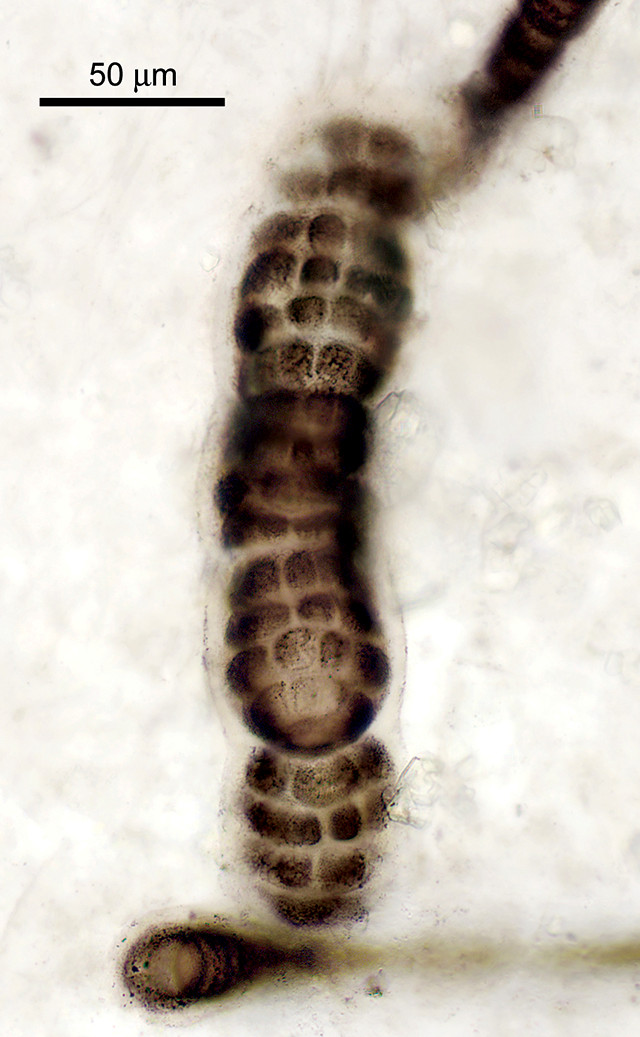
by Lucas Joel Tuesday, April 10, 2018

Bangiomorpha pubescens is a fossil red alga that's now the oldest-known direct ancestor of plants. Credit: Nicholas Butterfield.
Photosynthesis, the process by which plants harness sunlight to make their food, is a defining feature of plants and an important evolutionary development. But when photosynthesis evolved in ancient plant ancestors is not clear. The Precambrian fossil red alga Bangiomorpha pubescens, discovered in the Canadian Arctic in 1990 by University of Cambridge paleobiologist Nicholas Butterfield, displays evidence of traits that suggest it photosynthesized the way plants do, but the exact age of the fossil was also unknown. In a new study, researchers report an age for the alga of about 1.047 billion years, making it the oldest-known direct ancestor of plants.
The alga is also now the oldest-known eukaryote — or complex organism — that still has descendants alive today. “It stands out as simply the most important fossil for our understanding of early eukaryotic evolution,” says Timothy Gibson, a doctoral student at McGill University in Canada who led the new study in Geology.
It was long thought that B. pubescens could be as old as 1.2 billion years, Gibson says, but this age came with a lot of uncertainty. “It was only constrained to a 500-million-year window between 1.2 billion and 700 million years ago,” he says, which prevented researchers from saying anything definitive about the fossil’s significance as an ancestral organism. “We show that the fossil is about 200 million years older than the next [oldest] fossil that you’d compare it to,” which is a green alga, Gibson notes.
On Baffin Island in the Canadian Arctic, Gibson and his colleagues took samples of black shales from rock layers above and below where B. pubescens fossils occur. The team then dated the shales using rhenium-osmium radiometric dating, which is only possible in rocks like black shales with high levels of organic matter, Gibson explains, because the organic matter concentrates otherwise minute amounts of rhenium and osmium.
The age of the alga means that eukaryotes began diversifying much earlier than previously thought, during a stretch of time from about 1.8 billion to 0.8 billion years ago colloquially known as the “boring billion” because not much is thought to have happened in terms of the evolution of life. “This study throws a wrench into the mix,” Gibson says, and makes the boring billion seem a little livelier.
With a precise age for B. pubescens, the team was then better able to estimate when photosynthesis likely emerged in plant ancestors. In plants, photosynthesis happens in organelles called chloroplasts, which eukaryotes originally acquired through a process called “primary plastid endosymbiosis,” Gibson explains. “This occurred when an ancient eukaryote engulfed a photosynthetic bacterium” and assimilated its photosynthetic machinery into its genome.
To determine when this endosymbiosis and assimilation occurred, the team employed a molecular clock analysis, which estimates when certain evolutionary events happened based on the relatively constant rate of DNA evolution, using the new age for B. pubescens to help calibrate their molecular clock. The researchers reported that the endosymbiosis occurred about 1.25 billion years ago, likely in an unknown organism even older than B. pubescens.
This date still comes with uncertainty, however, because “molecular clock analyses on this timescale are notoriously unstable,” says Butterfield, who was not involved in the new study. Other such analyses looking at when eukaryotes acquired chloroplasts provide much older dates, he says.
While the new fossil age reveals the oldest-known eukaryotic ancestor that has living descendants, B. pubescens is only known from rock beds on Baffin Island. Such rarity means the actual age for photosynthesis in eukaryotes could be much older, says Andrew Knoll, a paleontologist at Harvard who was not part of the study. “This underscores that we still have a lot to learn about early eukaryote evolution,” he says.
© 2008-2021. All rights reserved. Any copying, redistribution or retransmission of any of the contents of this service without the expressed written permission of the American Geosciences Institute is expressly prohibited. Click here for all copyright requests.